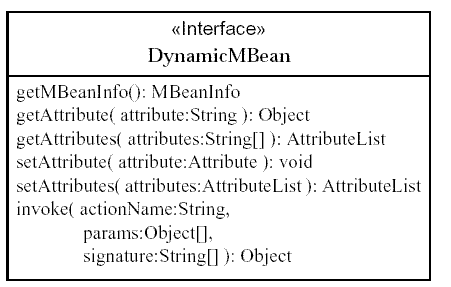JMX架构的了解 (MBean部分)
板桥里人 https://www.jdon.com 2003/1/5
我们前章举例的HelloMBean是StandardMBean,这是JMX中的MBean的一种,还有一种 叫DynamicMBean,这是JMX在运行期间能够控制它, 无论哪种MBean,他们的区别只是在他们如何被开发,而不是在它们如何被管理, JMX的Agent提供了处理这两种类型的抽象的处理方法,也就是说,一旦这两种MBean 被JMX的Agent管理,这两种MBean在外界看来没什么区别。
一个标准的standard MBean的Java class是通过它的attributes和operations 被外界管理的,Attributes是内部的一些属性变量,它通过getter 和 setter方法被外界管理 在HelloMBean中,它们是
public String getName();
public void setName(String name);
Operations 是这个class中其它愿意被管理的方法,在HellMBean中是
public void print()
所有这些方法需要在MBean接口中定义,然后通过introspection(内省机制) 显露给一个agent, 上述方法是制造一个可管理资源的最直接办法。
DynamicMBean
而在开发一个DynamicMBean时,attributes 和operations是通过方法调用 间接的显露给agent的。DynamicMBean 适合管理那些已经存在的资源和代码。
需要被JMX的Agent认为是 DynamicMBean,这个Java class或它的子类必须继承 一个DynamicMBean的标准接口。

getMBeanInfo:
DynamicMBean不象StandardMBean那样通过introspection(内省机制)向外界 显露他的attributes和operations,而是通过在运行时,返回这个方法的值来向
外界显露他的attribute names 和 types 以及 operation signatures 。 这个方法返回的是MBeanInfo实例.
getAttribute 和 getAttributes
这是获得相应的attribute name属性名称或属性名称表的值,这个类似StandardMBean的 getter方法,不同点是由调用者提供所需要的属性名,如 public Object getAttribute(String attribute_name) 不同于StandardMBean的getXXXX(Attribute_name)。setAttribute 和 setAttributes
这个类似StandardMBean的setter方法, 设置相应属性的name-value对。invoke
invoke方法是让外界来调用DynamicMBean的操作,这儿调用者必须提供 操作名称 作为参数传递的object和这些参数的类型,具体如: public Object invoke(String operationName, Object params[], String signature[])当DynamicMBean在JMX agent中注册后,DynamicMBean其实就和StandardMBean 是一样的,外界将首先通过getMBeanInfo获得一个管理接口,其中包含attributes 和 operations 名称,然后才将调用DynamicMBean的getters, setters 和invoke方法,
MBean原始类
从上面可以看到,MBean有一些自己规定的诸如MBeanInfo这样的原始类,一共有如下几种:
MBeanInfo - 罗列出所有的属性attribute, 操作operations, 构造器constructor
和 notification
MBeanFeatureInfo - 下面类的子类
MBeanAttributeInfo - 描述一个属性attribute
MBeanConstructorInfo - 描述一个构造器constructor MBean构造器是由签名单独地定义,这个签名是参数的次序和类型.
MBeanOperationInfo - 描述一个操作operation
MBeanParameterInfo - 描述一个操作或构造器的参数
MBeanNotificationInfo - 描述一个notification
通过与使用这些原始类,将你的具体资源就可以动态的嵌入DynamicMBean了.
我们看看下面HelloDynamic程序是如何使用这些原始类构成一个DynamicMBean的:
我们还以上章中的Hello为例,Hello是以Standard MBean来实现了对name的赋值和打印功能.那么通过使用Dynamic MBean我们也来实现这个功能,在这个资源中,有一个属性name以及操作方法print.下面示例展示如何将这个属性和这个操作方法使用DynamicMBean的原始类来实现:
|
// /** public class HelloDynamic //这是我们的属性名称 private MBeanInfo mBeanInfo = null; private MBeanAttributeInfo[] attributes = new MBeanAttributeInfo[1]; public HelloDynamic() { //设定一个属性 //设定构造函数 //operate method 我们的操作方法是print mBeanInfo = new MBeanInfo(className, description,
attributes, } public Object getAttribute(String attribute_name)
{ public AttributeList getAttributes(String[] attributeNames)
{ // if attributeNames is empty, return an empty result
list for (int i = 0; i < attributeNames.length; i++)
{ } public void setAttribute(Attribute attribute) { try { } } public AttributeList setAttributes(AttributeList attributes)
{ // if attributeNames is empty, nothing more to do // for each attribute, try to set it and add to the
result list if successfull } // Check for a recognized operation name and call
the corresponding operation } public MBeanInfo getMBeanInfo() { }
|
编制一个HelloAgent来调用这个HelloDynamic:
| // java imports // import java.util.*; import java.io.*; import java.net.*; // RI imports import com.sun.jdmk.comm.HtmlAdaptorServer; import javax.management.Attribute;
public static void main(String[] args) { // CREATE the MBeanServer String domain = server.getDefaultDomain(); server.createMBean(mbeanName,object_name); Attribute stateAttribute = new Attribute("Name","I
am big one"); String name = (String) server.getAttribute(object_name,"Name"); server.invoke(object_name,"print",null,null); } |
直接运行HelloAgent就可以在屏幕输出上得到
"Hello ,I am big one, this is from HelloDynamic"